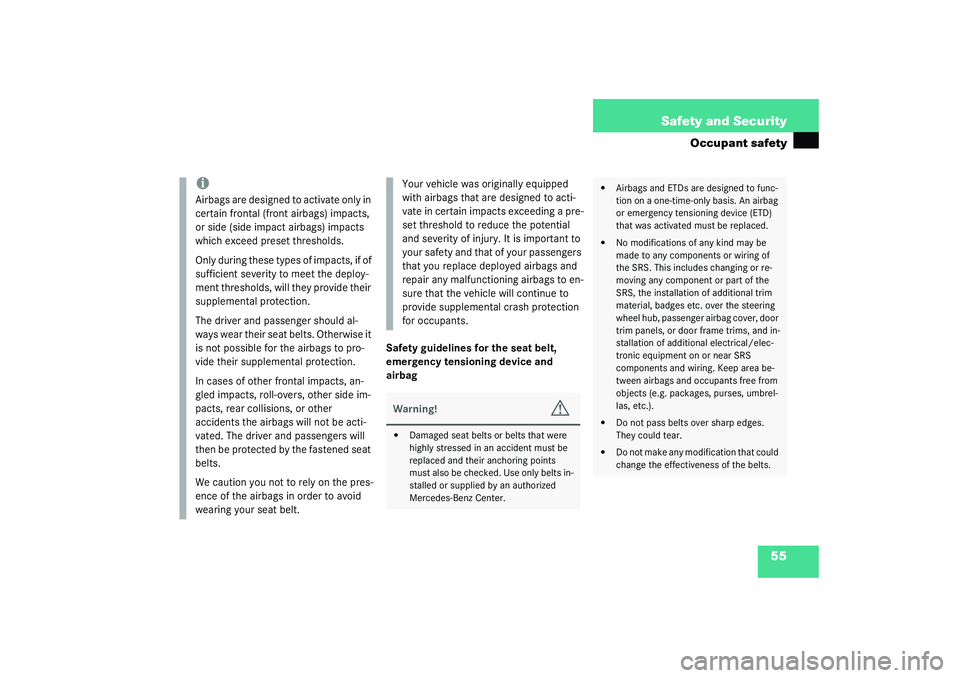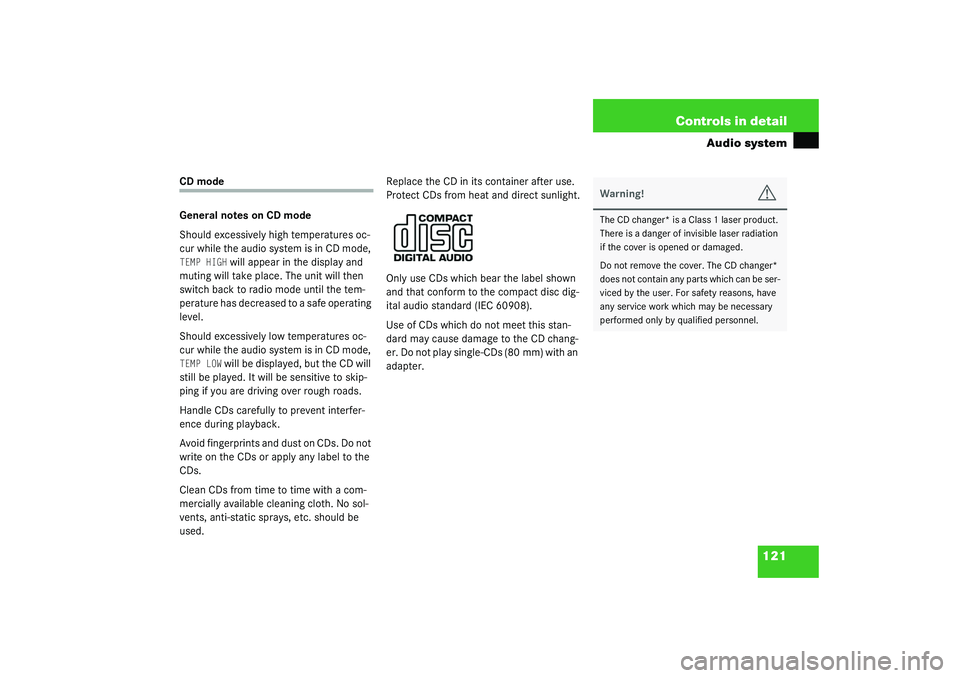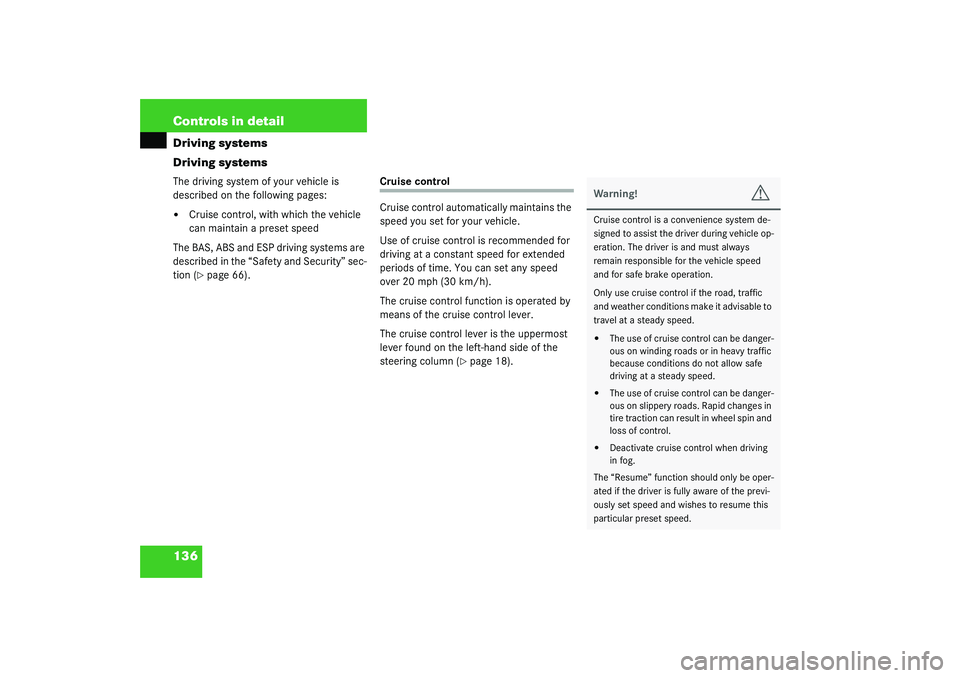Page 44 of 304
44 Getting startedDrivingHigh beam�
Push the combination switch forward.
The high beam symbol
A
in the
instrument cluster lights up.
More information can be found in the
“Controls in detail” section (
�page 85).
Windshield wipers
The combination switch is on the left of the
steering column.Combination switch1Switching on windshield wipers
2Single wipe�
Make sure that the ignition is switched
on.Switching on windshield wipers
�
Turn the combination switch to the de-
sired position depending on the inten-
sity of the rain.
0Windshield wipers off
IIntermittent wiping
IINormal wiper speed
IIIFast wiper speed
iTo signal minor directional changes,
move combination switch to point of
resistance only and release. The turn
signal blinks three times.
iFast wiper speedIII goes to settingII
when the vehicle is standing still.
Page 55 of 304

55 Safety and Security
Occupant safety
Safety guidelines for the seat belt,
emergency tensioning device and
airbag
iAirbags are designed to activate only in
certain frontal (front airbags) impacts,
or side (side impact airbags) impacts
which exceed preset thresholds.
Only during these types of impacts, if of
sufficient severity to meet the deploy-
ment thresholds, will they provide their
supplemental protection.
The driver and passenger should al-
ways wear their seat belts. Otherwise it
is not possible for the airbags to pro-
vide their supplemental protection.
In cases of other frontal impacts, an-
gled impacts, roll-overs, other side im-
pacts, rear collisions, or other
accidents the airbags will not be acti-
vated. The driver and passengers will
then be protected by the fastened seat
belts.
We caution you not to rely on the pres-
ence of the airbags in order to avoid
wearing your seat belt.
Your vehicle was originally equipped
with airbags that are designed to acti-
vate in certain impacts exceeding a pre-
set threshold to reduce the potential
and severity of injury. It is important to
your safety and that of your passengers
that you replace deployed airbags and
repair any malfunctioning airbags to en-
sure that the vehicle will continue to
provide supplemental crash protection
for occupants.Warning!
G
�
Damaged seat belts or belts that were
highly stressed in an accident must be
replaced and their anchoring points
must also be checked. Use only belts in-
stalled or supplied by an authorized
Mercedes-Benz Center.
�
Airbags and ETDs are designed to func-
tion on a one-time-only basis. An airbag
or emergency tensioning device (ETD)
that was activated must be replaced.
�
No modifications of any kind may be
made to any components or wiring of
the SRS. This includes changing or re-
moving any component or part of the
SRS, the installation of additional trim
material, badges etc. over the steering
wheel hub, passenger airbag cover, door
trim panels, or door frame trims, and in-
stallation of additional electrical/elec-
tronic equipment on or near SRS
components and wiring. Keep area be-
tween airbags and occupants free from
objects (e.g. packages, purses, umbrel-
las, etc.).
�
Do not pass belts over sharp edges.
They could tear.
�
Do not make any modification that could
change the effectiveness of the belts.
Page 87 of 304
87 Controls in detail
Lighting
Manual control
Activating�
Press switch2.
The interior lighting is switched on.
Deactivating
�
Press switch2 again.
The interior lighting is switched off.Night security illumination
If you exit the vehicle after driving with the
exterior lighting on, it switches on again for
added security for approximately
30 seconds after closing the last door.
The lamp-on time period can be changed at
your Mercedes-Benz Center.iIf the interior lighting is switched on
manually, it will not go out automatical-
ly. This could cause the battery to be-
come discharged.
iThe trunk lighting is switched on and
off simultaneously with the interior
lighting.
Page 121 of 304

121 Controls in detail
Audio system
CD mode
General notes on CD mode
Should excessively high temperatures oc-
cur while the audio system is in CD mode, TEMP HIGH
will appear in the display and
muting will take place. The unit will then
switch back to radio mode until the tem-
perature has decreased to a safe operating
level.
Should excessively low temperatures oc-
cur while the audio system is in CD mode,
TEMP LOW
will be displayed, but the CD will
still be played. It will be sensitive to skip-
ping if you are driving over rough roads.
Handle CDs carefully to prevent interfer-
ence during playback.
Avoid fingerprints and dust on CDs. Do not
write on the CDs or apply any label to the
CDs.
Clean CDs from time to time with a com-
mercially available cleaning cloth. No sol-
vents, anti-static sprays, etc. should be
used. Replace the CD in its container after use.
Protect CDs from heat and direct sunlight.
Only use CDs which bear the label shown
and that conform to the compact disc dig-
ital audio standard (IEC 60908).
Use of CDs which do not meet this stan-
dard may cause damage to the CD chang-
er. Do not play single-CDs (80 mm) with an
adapter.
Warning!
G
The CD changer* is a Class 1 laser product.
There is a danger of invisible laser radiation
if the cover is opened or damaged.
Do not remove the cover. The CD changer*
does not contain any parts which can be ser-
viced by the user. For safety reasons, have
any service work which may be necessary
performed only by qualified personnel.
Page 136 of 304

136 Controls in detailDriving systems
Driving systemsThe driving system of your vehicle is
described on the following pages:�
Cruise control, with which the vehicle
can maintain a preset speed
The BAS, ABS and ESP driving systems are
described in the “Safety and Security” sec-
tion (�page 66).
Cruise control
Cruise control automatically maintains the
speed you set for your vehicle.
Use of cruise control is recommended for
driving at a constant speed for extended
periods of time. You can set any speed
over 20 mph (30 km/h).
The cruise control function is operated by
means of the cruise control lever.
The cruise control lever is the uppermost
lever found on the left-hand side of the
steering column (
�page 18).
Warning!
G
Cruise control is a convenience system de-
signed to assist the driver during vehicle op-
eration. The driver is and must always
remain responsible for the vehicle speed
and for safe brake operation.
Only use cruise control if the road, traffic
and weather conditions make it advisable to
travel at a steady speed.�
The use of cruise control can be danger-
ous on winding roads or in heavy traffic
because conditions do not allow safe
driving at a steady speed.
�
The use of cruise control can be danger-
ous on slippery roads. Rapid changes in
tire traction can result in wheel spin and
loss of control.
�
Deactivate cruise control when driving
in fog.
The “Resume” function should only be oper-
ated if the driver is fully aware of the previ-
ously set speed and wishes to resume this
particular preset speed.